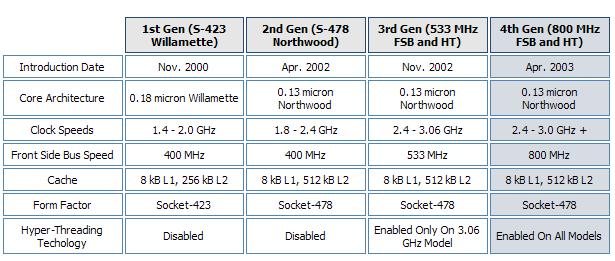 |
|
|
|
In the Forums... |

Posted: June 23rd, 2003
It is fair to say the Pentium 4 processor has been around for an extensive amount of time reaching many homes and businesses be it in desktop, workstation or notebook form. While the name has not changed within its lifespan, the aspects improving on its ability to deliver more performance for yet tomorowís software have. Most important was the change to 512K L2 cache and a faster FSB of 533MHz allowed better memory access reducing the latency required to both locate and fetch data, an issue of great significance with the ever increasing clock speeds. These now well into the multiple GHz range have grown steadily depositing own rewards towards the performance equation. However we look upon Intel's Pentium 4 processor it is fair to name it a matured product showcasing a large combined technological effort. Examining this latest Pentium 4's FC-PGA2 Socket 478 packaging marks no changes from its predecessor whereas internally the core has been revised now entering its third revamp since the Northwood's launch back in early 2002. While the recent C1 stepping was identified by the number 7 this new D1 core is represented by a 9. To differentiate from previous models Intel uses a ďCĒ notation next to processorís name. Entrance into the year 2003 happened equally with a new objective for Intel's Netburst architecture. Throughout 2002 the direction has been scaling clock speed from 2GHz through to 3.06GHz. Within this time the Pentium 4 became faster internally but also in far more need of bandwidth, or in other words demand to be fed data and fast. Introducing the 800MHz FSB Pentium 4 has meant boosting the link between the processor and memory to an impressive 6.4GB/second, 50% more than the 533MHz FSB had to offer. Opening up a wider access path to the processor unlocks the facility to wholly absorb the raw bandwidth a dual PC3200 DDR SDRAM memory interface has to offer, also with a theoretical peak rate of 6.4GB/second. Such increases in the delivery of data serve to efficiently supply the architecture with blocks for processing leaving the CPU to do more and idle less. As internal clock speeds increase so does the effect an 800MHz FSB has on system speed. In addition to debuting the 800MHz FSB Pentium 4 as an all better optimized solution Intel now brings the most recently yearned trait, Hyper Threading, to all its processor speed grades from 2.4GHz upwards right to 3.2GHz launched today. Because how HT effectively imposes a more streaming manner due to making use of otherwise idle CPU execution units it should benefit substantially from the increased flow of information brought to its disposal, the fabrication of a new FSB and high bandwidth memory interface. As we can recall Hyper threading conjures the system into having two logical CPUís just as would appear in a normal SMP workstation (Symmetrical Multi-Processing). The truth of the subject is although shown as dual processors HT makes one physical CPU perform given tasks concurrently. These often referred to as threads either work on the same data or not as the case may be based on a machineís extensive use of software. HT puts extra stress on data bandwidth efficiency and as such applications falling into the video/audio encoding category are expected to profit most where the system is really made to toil. Combining the 800MHz FSB and dual channel PC3200 DDR RAM collectively with HT resembles Intelís new objective as we initially indicated above, in essence the shift from just pure processor clock speed to an all superior platform harnessing the potential to improve utilization of each clock cycle. The Pentium 4C is based on a revision of the Northwood core as we mentioned above thus still comes manufactured using the 130nm process. Due to this the heat they generate especially at 3GHz or more becomes a prime topic and with Hyper Threading active is raised yet another stage further. With every new stepping we have seen a small jump in the processorís core voltage (except the shift from the Willamette to Northwood core) in stages of 0.25V. To combat the issue of heat the D1 stepping introduces a method of varying the core voltage on a per silicon basis. During the production process each individual core is validated to run at a specified speed, the same methodology now applies to core voltage. Every piece of silicon differs in its performance characteristics thus better silicon receives a lower voltage whereas slightly poorer silicon is set to a higher voltage, the values themselves range from 1.475V to 1.55V. The end result is precisely pumping only as much core electrical current the given silicon requires to successfully operate at its quoted speed; the output heat is therefore decreased. The true evolution of the Pentium 4 processor now with an 800MHz FSB rests not solely within its modifications but its surroundings. It is largely thanks to the i865/i875 series chipsets that these devices show off in a yet new enhanced way what the Netburst architecture can do if set in a fitting neighbourhood. Intel holds back from fast ramping clock speeds this year in exchange for gaining pace in increasing sub-system efficiency utilizing now standard Hyper Threading and a new higher bandwidth FSB. These combined by means of the i865/i875 chipset family at present boost Pentium 4ís productiveness while also pave the way for Intelís next processor/platform, the Prescott.

|
||
|
| |||
|---|---|---|---|